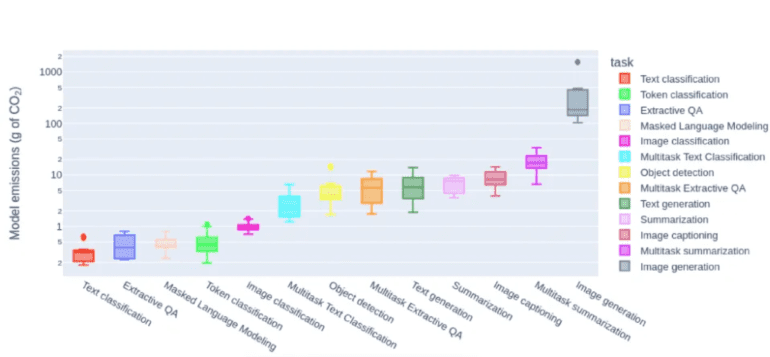TL;DR:
- Researchers from Hugging Face and Carnegie Mellon quantify AI’s carbon footprint.
- Generating AI images equals the energy used to charge a smartphone.
- AI-generated text consumes only 16% of a smartphone’s energy.
- The study assesses 13 AI tasks, revealing varying environmental impacts.
- Tasks involving content generation, like image creation, are the most energy-intensive.
- Transparency is urged within the machine learning community.
- ChatGPT’s massive user base highlights AI’s environmental scale.
Main AI News:
In a groundbreaking collaboration between AI startup Hugging Face and Carnegie Mellon University, researchers have undertaken a meticulous examination of the environmental impact of artificial intelligence in the creation of images and text. The study’s findings, published in a bid to raise awareness about the carbon footprint of AI, shed light on the energy consumption and carbon emissions associated with various AI tasks.
The research reveals that generating AI images, whether for stock imagery or identification photos, carries a carbon footprint on par with the energy required to charge a smartphone. However, in striking contrast, the creation of AI-generated text, used extensively in chatbots and content editing, is remarkably energy-efficient, consuming only 16 percent of the energy needed to charge a smartphone to full capacity.
Going beyond image and text generation, the study encompassed a comprehensive assessment of 13 diverse AI tasks, spanning from summarization to text classification. Researchers meticulously quantified the amount of carbon dioxide produced per 1000 grams for each task. To ensure the study’s fairness and diversity, experiments were conducted across 88 different models utilizing 30 distinct datasets. In each task, 1,000 prompts were executed, enabling the collection of valuable data on both energy consumption and carbon emissions.
The findings unearthed a critical revelation: AI tasks that involve the generation of new content, such as text generation, summarization, image captioning, and image generation, stand out as the most energy-intensive. Notably, image generation registered the highest levels of carbon emissions, while text classification emerged as the least energy-intensive task.
In light of these findings, the researchers emphasize the importance of transparency within the machine learning community. They call upon scientists and practitioners to openly acknowledge and communicate the nature and environmental consequences of their AI models. Although the energy consumption linked to a single AI image may seem inconsequential, it becomes a matter of concern when considering the widespread use of AI models in today’s digital landscape.
A prime example is ChatGPT, developed by OpenAI, which, at its peak, boasted a user base of over 10 million daily users and continues to engage 100 million monthly active users. The study underscores the collective responsibility of the AI community to mitigate the environmental impact of AI technologies and advocates for sustainable practices in AI development.
Conclusion:
The study emphasizes the need for environmental awareness in AI development. It highlights the stark contrast in energy efficiency between image and text generation tasks. For the market, this underscores the importance of sustainable AI practices and the potential for eco-friendly AI solutions to gain prominence as environmental concerns grow.

